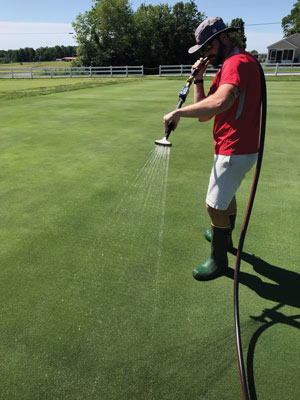 Irrigation is typically applied immediately following fungicide applications when targeting root diseases in putting greens. However, the fate of fungicides following post-application mowing and irrigation is not well documented. The objective of this study was to determine the influence of post-application mowing and irrigation timing on the amounts of fungicide in turfgrass clippings and the soil profile.
Irrigation is typically applied immediately following fungicide applications when targeting root diseases in putting greens. However, the fate of fungicides following post-application mowing and irrigation is not well documented. The objective of this study was to determine the influence of post-application mowing and irrigation timing on the amounts of fungicide in turfgrass clippings and the soil profile.
Single fungicide applications of pyraclostrobin, triadimefon and penthiopyrad were applied, and 0.25 inch (0.635 centimeter) of post-application irrigation was applied either immediately or six hours after fungicide application.
Turfgrass clippings were collected at zero, one or three days after treatment. Soil cores were collected zero, one, three, seven and 14 days after treatment and dissected into remaining aboveground vegetation (verdure/thatch) at depths of 0 to 1 inch (2.5 centimeters), 1 to 2 inches (5 centimeters) and 2 to 3 inches (7.6 centimeters). All samples were homogenized, and fungicide residue was analyzed using liquid chromatography mass spectrophotometry.
Fungicide recovery as percent of fungicide applied ranged from 90% to 93% for pyraclostrobin, 92% to 99% for triadimefon, and 92% to 95% for penthiopyrad at zero days after treatment. Only a minor amount of fungicide (0.19% to 2.31%) was removed with turfgrass clippings regardless of the mowing and irrigation treatment. Fungicide was detected in the 2- to 3-inch depth at 14 days after treatment only when irrigation occurred immediately after fungicide application.
Less penthiopyrad was detected in the remaining aboveground vegetation, and total fungicide recovery was greater through five days after treatment for penthiopyrad than for pyraclostrobin and triadimefon. More penthiopyrad than pyraclostrobin or triadimefon was detected in the 0- to 1-inch depth at one day after treatment.
Irrigating immediately and delaying mowing following fungicide application resulted in greater fungicide movement and recovery.
— Cameron Stephens, James P. Kerns, Ph.D., and Travis W. Gannon, Ph.D., North Carolina State University, Raleigh, N.C.
Editor’s note: A version of this summary was published in the 2018 ASA-CSSA Meeting Abstracts, ASA and CSSA, Madison, Wis.
Teresa Carson is GCM’s science editor.